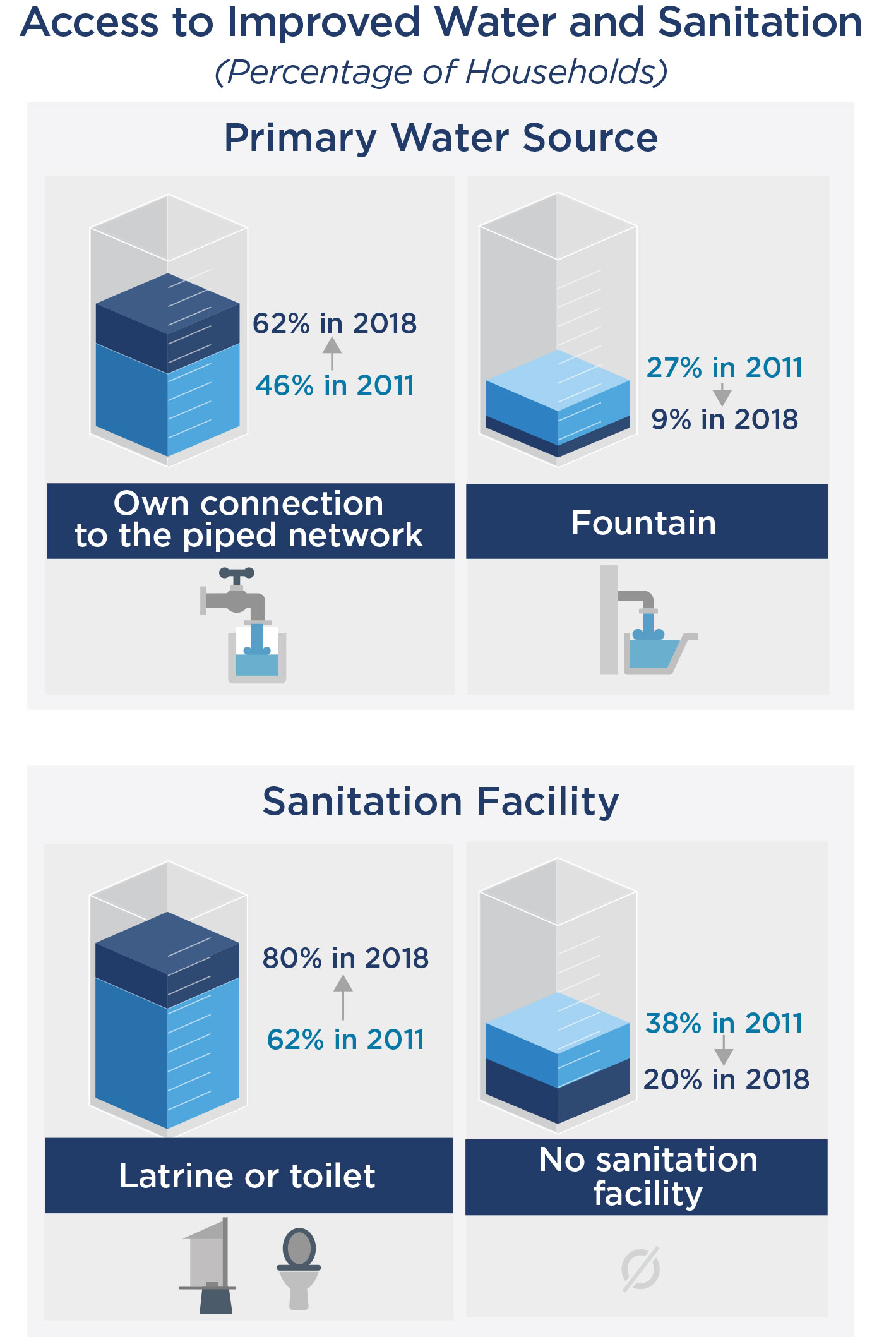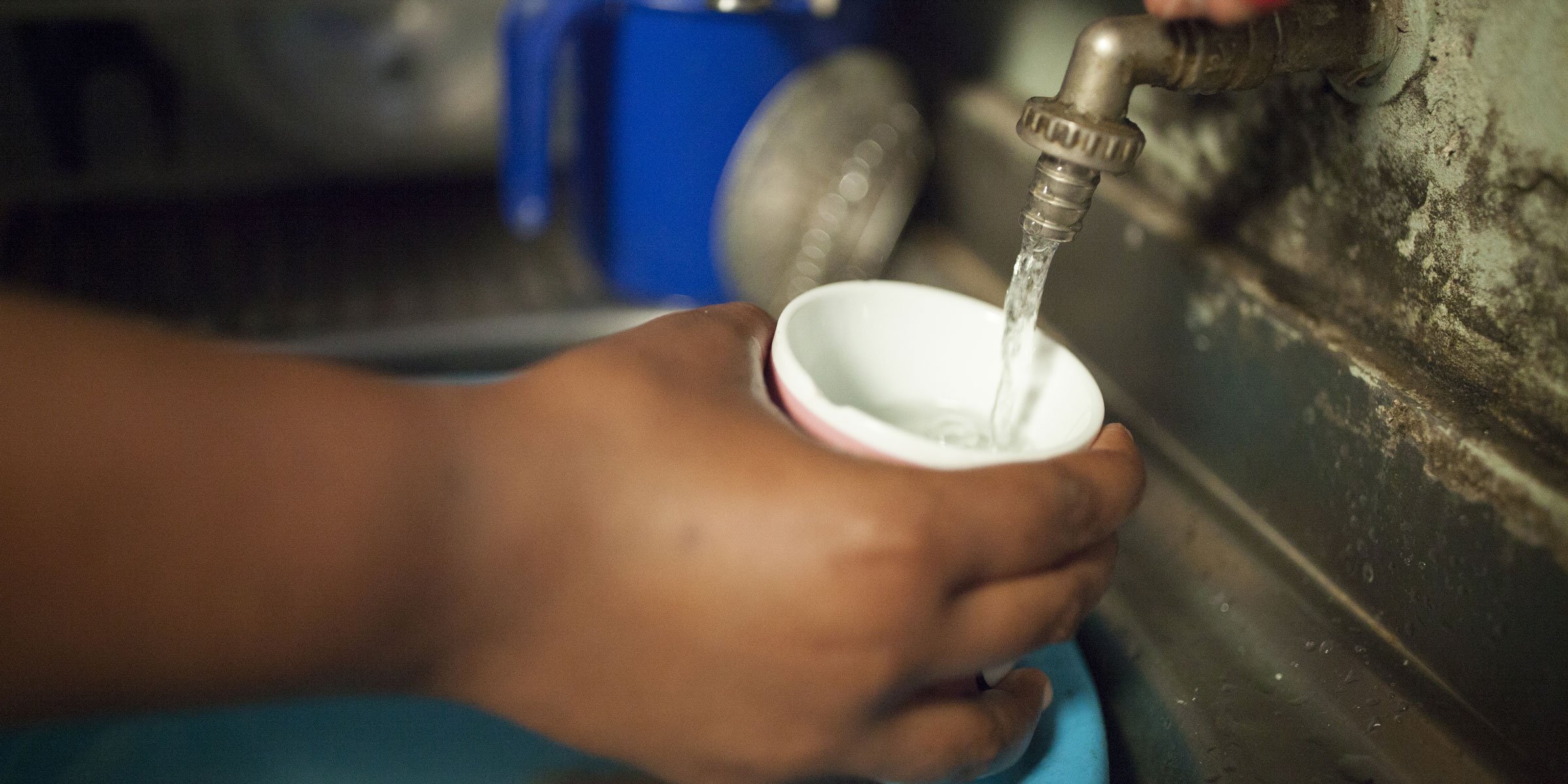Program Overview
MCC’s $66.2 million Cabo Verde Compact II (2012-2017) funded the $41.1 million Water, Sanitation, and Hygiene (WASH) Project. The project aimed to improve service delivery and increase households’ access to piped water and sanitation by strengthening the institutional and regulatory environment; creating a new, financially sustainable corporatized water utility; funding infrastructure rehabilitation and expansion; and subsidizing household connections to the water and sewer networks. The reforms were expected to increase government and donor investment in the WASH sector. The project was based on the theory that increasing access to piped water would lead to increases in household productivity, particularly for poor households, by reducing the cost and time spent collecting water and increasing the amount of water consumed.
Download the Portuguese translated evaluation brief
Evaluator Description
MCC commissioned Mathematica to conduct an independent interim performance evaluation of the Water, Sanitation, and Hygiene Project. Full report results and learning: https://data.mcc.gov/evaluations/index.php/catalog/212.
Key Findings
National Policy and Institutional Reform
- Authority for coordinating the WASH sector was consolidated under a few regulatory entities, and frameworks to guide policy-making were enacted into law.
- These regulatory entities are still in need of technical assistance and clearer definitions of their roles and responsibilities.
Utility Reform
- Águas de Santiago (AdS), a new water utility, was successfully created, though the process took longer than expected.The new utility was still dependent on external technical assistance at the end of the compact.
- AdS has shown mixed progress in its first years. It is too soon to judge its financial sustainability.
Infrastructure Improvements
- The infrastructure grant facility (IGF) awarded $20 million in funds, reaching all but two of Cabo Verde’s nine islands.
- Despite considerable efforts to set up a new fund that would continue after the compact for WASH infrastructure investments, the plans were not implemented.
Household Access to Piped Water and Sanitation
- The infrastructure grants and connection subsidies contributed to increased access to the piped water and sanitation networks. These efforts did not result in time savings (since the time to collect water was already quite low for most households), but they did contribute to a reduction in the proportion of households without access to a sanitation facility.
Evaluation Questions
This interim performance evaluation was designed to answer the following questions, with a focus on short-term results (within one year of the end of the compact). Some questions are linked to multiple project activities and results and are answered more comprehensively in the full report.
- 1
Were the activities/sub-activities implemented as designed? What were implementation challenges and successes? - 2
How did the political and economic incentives of different sector actors affect the implementation, sustainability, and efficacy of the WASH Project? - 3
Is the grant facility a sustainable institution in Cabo Verde that will catalyze additional financing for WASH infrastructure? - 4
Was the tariff reform outcome pro-poor (progressive), regressive, or neutral in Santiago? Does the current tariff structure allow for cost-recovery by AdS? - 5
Was the WASH Project as a whole effective at increasing the management efficiency and sustainability of the sector? - 6
What has been the effect of the WASH Project on access to, quality, continuity, and cost of water and sanitation services for households in Cabo Verde? On gender and social equality in access to and cost of water and sanitation services?
Detailed Findings
National Policy and Institutional Reform
The project supported the creation of the National Agency for Water and Sanitation, which was responsible for policy and planning for the WASH sector and regulating the quality of water provided by utilities. Under the new regulatory model, when the Economic Regulatory Agency sets tariffs for corporate utilities, it balances financial sustainability with the utilities’ mandate to provide affordable, high quality services. However, Cabo Verde does not have a national system for identifying the poor, so there was no way to target water subsidies to households in need.

Construction of pipe trenches
Utility Reform
Many factors facilitated the establishment of the new water utility, AdS, including effective communication strategies and stakeholder engagement, financial support from the WASH Project, and the example of other successful corporatized utilities in Cabo Verde. In its first two years, AdS added over 1800 new customers and increased the volume of water it provided. AdS estimated that in 2018 roughly 60 percent of the water in its network was non-revenue water, either leaking out or never billed to customers. AdS worked to find ways to reduce non-revenue water, but it remains a major financial challenge that the utility needs to do more to address. At the same time, AdS made notable improvements in the bill collection rate.
lthough the majority of AdS’s customers were satisfied with various dimensions of the service quality they received from AdS, there was still ample room to improve. In particular, availability of piped water was highly variable. Evaluation survey data showed that AdS’s increasing block tariff (in which customers were charged a higher price for higher levels of consumption) was highly regressive, since most of the subsidized water in the first block was consumed by non-poor customers. Moreover, because almost half of AdS’s billed water fell in the first block, the utility struggled to achieve cost recovery: the price of the first block was barely above what AdS paid for the desalinated water it distributes.

Infrastructure Improvements
In the short run, connection subsidies administered by local NGOs were more effective at increasing poor households’ access to improved water and sanitation than construction projects to extend the network into areas where poor households live. That said, network extensions could eventually enable more households to connect overall than simply providing subsidies for poor households to connect to existing networks.
Household Access to Piped Water and Sanitation
Access to piped water increased compared to the project baseline in 2011, and the share of households that relied on public fountains fell. Access to improved sanitation also increased since baseline, but a fifth of the population still does not have access to any sanitation facility. Furthermore, the share of households without any sanitation facility was reduced by nearly half between 2011 and 2018.
Water consumption was relatively low on Santiago—the average household consumed 40 liters per person per day in 2018. Poor households, who are less likely to be connected to the piped water network, consumed far less water than non-poor households—an average of 24 liters per person per day. While there is no reliable baseline data for this outcome, it will be possible to compare water consumption between the interim and endline rounds of the evaluation in the future.

Time spent collecting water was not a major burden for most households in 2018. Many households continued to collect water regularly; roughly half of these households had their own connection to the piped water network. Most households who collected water spent less than two minutes per person per day on average, since many households who collected water did not do so every day. Collecting water from a neighbor’s connection was fairly quick (seven minutes per trip on average) whereas households who collected from public fountains spent almost half an hour per trip. There was minimal scope for the WASH Project to lead to increased household productivity. Although more households now have access to piped water, this did not generate major time savings since the time required to collect water was already quite low for most households. There was also no evidence that increased access to piped water enabled income-generating activities.
MCC Learning
Building on existing reform efforts and coordinating with other donors can improve impact and sustainability of policy and institutional reform. Given how long it may take to fully reform a sector, it should be clear how the reform process will continue once MCC’s timeline is up.
Consider the need for sustainability of infrastructure grant facilities in project design and early on in implementation, particularly where the grant facility only fills a funding gap and there is need for a continuation mechanism for the grant facility after the compact.
Primary data collected through the evaluation combined with administrative data can be useful to a utility. It is important to consider how to share with them results from data collection and analyses conducted for the purpose of an evaluation.
Evaluation Methods

Construction on rural network extensions in Santiago
This performance evaluation assesses the short-run effects of the project within the first year after its completion, using the project logic model developed by MCC to determine outcomes and assumptions to be explored. The evaluation consists of a process evaluation of project activities; a pre-post analysis of household survey data and administrative data; and case studies of a targeted selection of infrastructure projects. The interim findings in this brief are drawn from the following data sources:
- Interviews with over 60 stakeholders involved in the design and implementation of the project.
- Documents and administrative records from project stakeholders and implementers.
- Administrative data from the AdS including operational, billing, and payment information from 2017 and 2018.
- Household survey data from representative samples of the Santiago population in 2011 (N=999 households) and 2018 (N=998).
- Household survey from beneficiaries who received subsidized connections to the piped water network (baseline N=1044 in 2015 and follow-up N=583 in 2018).
- Focus group discussions with 18 groups of household beneficiaries.
- Ultrasonic and AdS meter data collected for a convenience sample of 214 households in Praia to assess the accuracy of the utility’s meters.
Next Steps
Results from a final round of the performance evaluation are expected to be available in 2022.


